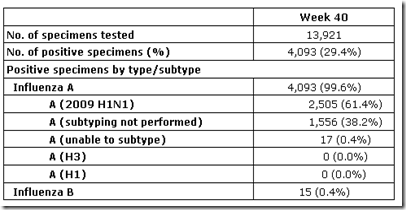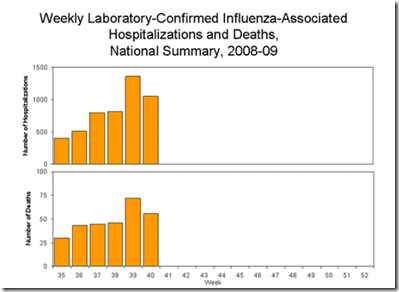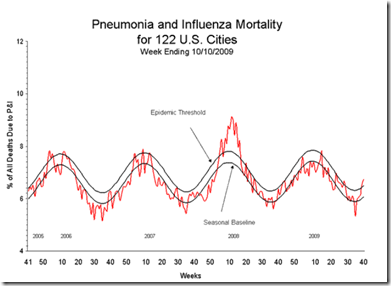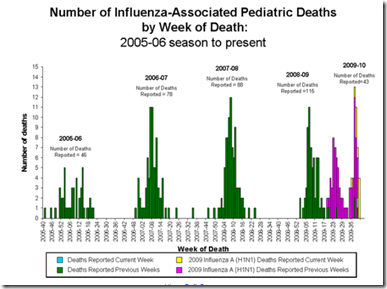# 3844
Every Friday afternoon we get the latest updated FluView figures from the CDC. This is a comprehensive look at the level of flu activity around the US, for the week ending 7 days previously.
Late yesterday, we received the FluView for week 40, which ended October 10th. Although this is week 40 of the calendar year, many of the tracking systems used by the CDC were reset to zero on August 30th, to reflect the (early) start of the new flu season.
The picture we get is of a nation in the midst of a serious influenza outbreak, much earlier in the year than is generally seen.
I’ve pulled out some excerpts, but there is a lot more to look at on the FluView page.
First some highlights, followed by a cautionary epilogue.
2009-2010 Influenza Season Week 40 ending October 10, 2009
All data are preliminary and may change as more reports are received.
Synopsis:
During week 40 (October 4-10, 2009), influenza activity increased in the U.S.
- 4,093 (29.4%) specimens tested by U.S. World Health Organization (WHO) and National Respiratory and Enteric Virus Surveillance System (NREVSS) collaborating laboratories and reported to CDC/Influenza Division were positive for influenza.
- All subtyped influenza A viruses being reported to CDC were 2009 influenza A (H1N1) viruses.
- The proportion of deaths attributed to pneumonia and influenza (P&I) was above the epidemic threshold.
- Eleven influenza-associated pediatric deaths were reported. Ten of these deaths were associated with 2009 influenza A (H1N1) virus infection and one was associated with an influenza A virus, for which subtype is undetermined.
- The proportion of outpatient visits for influenza-like illness (ILI) was above the national baseline. All 10 regions reported ILI above region-specific baseline levels.
- Forty-one states reported geographically widespread influenza activity, Guam and eight states reported regional influenza activity, one state, the District of Columbia, and Puerto Rico reported local influenza activity, and the U.S. Virgin Islands did not report.
U.S. Virologic Surveillance:
WHO and NREVSS collaborating laboratories located in all 50 states and Washington D.C. report to CDC the number of respiratory specimens tested for influenza and the number positive by influenza type and subtype. The results of tests performed during the current week are summarized in the table below.
Pneumonia and Influenza Hospitalization and Death Tracking:
This new system was implemented on August 30, 2009, and replaces the weekly report of laboratory confirmed 2009 H1N1-related hospitalizations and deaths that began in April 2009. Jurisdictions can now report to CDC either laboratory confirmed or pneumonia and influenza syndromic-based counts of hospitalizations and deaths resulting from all types or subtypes of influenza, not just those from 2009 H1N1 influenza virus.
To allow jurisdictions to implement the new case definition, counts were reset to zero on August 30, 2009.
From August 30 – October 10, 2009, 4,958 laboratory-confirmed influenza associated hospitalizations, 292 laboratory-confirmed influenza associated deaths, 15,696 pneumonia and influenza syndrome-based hospitalizations, and 2,029 pneumonia and influenza syndrome-based deaths, were reported to CDC. CDC will continue to use its traditional surveillance systems to track the progress of the 2009-10 influenza season.
Antigenic Characterization:
CDC has antigenically characterized 94 2009 influenza A (H1N1) viruses collected since September 1, 2009. No seasonal A(H1N1), A(H3N2) or B viruses collected during this period were available for testing.
All ninety-four 2009 A (H1N1) viruses are related to the A/California/07/2009 (H1N1) reference virus selected by WHO as the 2009 H1N1 vaccine virus.
Pneumonia and Influenza (P&I) Mortality Surveillance
During week 40, 6.7% of all deaths reported through the 122-Cities Mortality Reporting System were due to P&I. This percentage was above the epidemic threshold of 6.5% for week 40.
Influenza-Associated Pediatric Mortality
Eleven influenza-associated pediatric deaths were reported to CDC during week 40 (Arizona, Colorado, Idaho, Kentucky, Louisiana [2], North Carolina, Ohio, South Carolina, and Tennessee [2]). Ten of these deaths were associated with 2009 influenza A (H1N1) virus infection and one was associated with an influenza A virus for which the subtype is undetermined.
Obviously, this is an eagerly awaited compilation of weekly influenza information. While it is an impressive collection of data, it isn’t the full picture of influenza across the nation, and the CDC has never represented it as such.
Still, I continue to hear people quote the number of fatalities from this CDC report as if it represents the total number killed by influenza each week.
It doesn’t.
With the exception of the pediatric P&I mortality tracking, none of these reporting systems attempts to measure the total number of flu deaths in the nation. Even these pediatric numbers may be incomplete, and the reporting of some cases often lags weeks behind.
These reports are valuable snapshots of sampling from around country, which help us gauge the relative seriousness of the current flu season – not an accurate count of hospitalizations or deaths.
The 122 MRS report, for instance, only reports from those 122 cities, and only reports on death certificates with Influenza or Pneumonia listed as a cause of death. The CDC describes the difficulties of counting deaths this way:
Exact numbers of how many people died from flu this season cannot be determined.
Flu-associated deaths (which have laboratory confirmed influenza), are only a nationally notifiable condition among children; however not all pediatric influenza deaths may be detected and reported and there is no requirement to report adult deaths from influenza.
In addition, many people who die from flu complications are not tested, or they seek medical care later in their illness when flu can no longer be detected from respiratory samples.
However, CDC tracks pneumonia and influenza (P&I) deaths through the 122 Cities Mortality Reporting System. This system collects information each week on the total number of death certificates filed in each of the 122 participating cities and the number of death certificates with pneumonia or influenza listed as a cause of death.
The 122 Cities Mortality Reporting system helps gauge the severity of a flu season compared with other years. However, only a proportion of all P&I deaths are influenza-related and, as noted, most flu deaths are not lab confirmed.
It is frustrating, I know. And it sounds like it ought to be an easy question to answer:
How many people died from the pandemic last week?
But the truth is, it is impossible to answer. And it isn’t a failing of the CDC, it is simply the reality.
More than 6,000 people die each day in the US, and very few are autopsied to determine the cause of death. Even those that receive a post mortem exam are unlikely to be tested for influenza.
And of course, influenza can weaken a person to the point that they die a week, or even a month, after the infection has cleared. Testing wouldn’t show the virus at that point, but the flu could legitimately be seen as a contributing cause of death.
While it may be unsatisfying to a lot of people, there really is no way to accurately count the number of influenza-related deaths in this country.
That is why the CDC uses the mathematically derived estimate of 36,000 flu-related deaths each year. It’s a ballpark number, based on an average of estimated (not counted) deaths over a 10-year span.
I fully expect that after this pandemic is over – probably a year or two from now - number crunchers will look at the data and give us their interpretation of the impact of this virus. An estimate, or more likely – an estimated range of deaths - from novel H1N1.
It is unlikely to satisfy anyone, of course.
But it will give academics, flublogians, and arm-chair editorialists something to argue over until the next pandemic comes down the pike.



